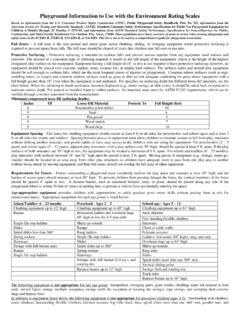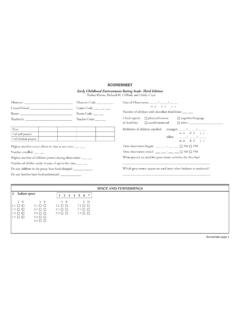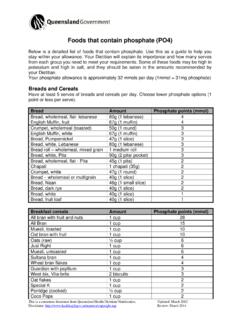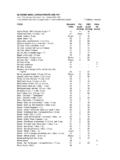Transcription of ECERS-3 101 Chapter 1 Learner Notes - ersi.info
1 ECERS-3 101 Chapter 1 Learner Notes Use this packet to record your Notes as you work through this Chapter . Name:_ Date:_ Help Resources If you experience any technical issues, please contact Technical Support: Email: Phone: 919-438-2380 (8AM to 8PM EST) When reporting technical issues, be sure to include the page number of the Chapter (found in the lower right corner of the window). If you need content-specific help, you may e-mail the ERSI staff at: 1 This packet is designed for you to take Notes as you work through Chapter 1 of the ECERS-3 101 course. This packet will be useful as you prepare for the end of course test, which comes at the end of Chapter 2. Basic Needs of Children What are the 3 basic needs of children? (1) (2) (3) The Environment Rating Scales use information from Caring for Our Children, published by the American Academy of Pediatrics and the American Public Health Association, along with the USDA Meal Guidelines, in developing standards related to health practices.
2 The following pages contain resources you will need when conducting an observation. It is recommended that you tape this resources in your Scale. Make sure you have a copy of the Early Childhood Environment Rating Scale, Third Edition before continuing with this course. 2 DIAPERING AND HANDWASHING Diapering Procedure 1. Before beginning the diapering procedure, clean your hands by using proper hand hygiene (handwashing or use of hand sanitizer according to directions). 2. To minimize contamination, prepare for diapering by getting out all of the supplies needed for the diaper change and placing them near, but not on, the diapering surface, for example: Enough wipes for the diaper change, including cleaning the child s bottom and wiping the teacher s and child s hands before putting on the clean diaper (wipes must be taken out of their container) A clean diaper A plastic bag for soiled clothes and a set of clean clothes (if soiled clothing is anticipated) Non-porous gloves (if used) A dab of diaper cream on a disposable paper towel (if used) Changing table paper (if used) to cover the table from the child s shoulders to feet (in case it becomes soiled and must be folded over to create a clean surface during the change) 3.
3 Place the child on diapering table. Remove clothing to access diaper. If soiled, place clothes into a plastic bag. 4. Remove soiled diaper and place into a lined, covered, hands-free trash container. 5. Use wipes to clean child s bottom from front to back (one wipe per swipe) and throw away into trash container. The diaper can also be left open under the child during the cleaning step and then discarded with the soiled wipes before continuing with Step 6. If gloves are used, they must be discarded at this time. 6. Use a wipe to remove soil from your hands and throw into trash container. 7. Use another wipe to remove soil from child s hands and throw into trash container. 8. Put on clean diaper and redress the child. 9. Wash the child s hands following the proper handwashing procedure (use of hand sanitizer is also acceptable for children 2 and older). Return the child to the play area without touching any other surfaces.
4 10. Clean the diapering surface by spraying it with a soapy water solution and drying with a paper towel or by wiping it with a water-saturated paper towel or wipe. 11. Disinfect the diapering surface by spraying it with disinfectant-strength bleach-water solution ( cup bleach per gallon of water) and wait at least 2 minutes before wiping (or allow to air dry). Another EPA approved disinfectant, used according to directions, can be used instead of bleach and water. 12. Clean your hands by using proper hand hygiene (handwashing or use of hand sanitizer according to directions) Handwashing Procedure 1. Moisten hands with water and use liquid soap. 2. Rub hands together away from the flow of water for 20 seconds. 3. Rinse hands free of soap under running water. 4. Dry hands with a clean, disposable paper towel or air dry with a blower. 5. Turn off faucet using paper towel. 6. Throw the used paper towel into a hands-free trashcan.
5 Information taken from Caring for Our Children: The National and Safety Performance Standards for Out-of-Home Care, 3rd edition, American Academy of Pediatrics, American Public Health Association, and National Resource Center for Health and Safety in Childcare (2011). 3 TABLE WASHING PROCEDURE 1. To remove gross soil, spray the table (or highchair tray) with a soap-water solution and wipe dry with a disposable paper towel. 2. To sanitize the eating surface, spray the table/tray with bleach-water solution and wait at least 2 minutes before wiping with a disposable towel or allow to air dry, in order to allow the solution to kill germs. The surface cannot be sprayed and immediately wiped. Additional precautions Sponges should not be used for sanitizing tables because they soak bacteria away from the surface of the sponge, which then cannot be easily reached in the interior of the sponge by the sanitizing agent.
6 If wet cloths are used, a separate cloth is required for each table/tray, and cloths cannot be returned to soak in a bleach-water solution. Food should not be put directly on the table or highchair tray because eating surfaces are more likely to be contaminated than disposable plates or washed and sanitized dishes If highchair trays are used as eating surfaces, the trays should be washed and sanitized in the same way as plates and other food service utensils. In case different children rotate through snack, each place must be cleaned and sanitized between use by different children. Sanitizing solution should not be sprayed while children are seated at the table. From All About the ITERS-R (2004), Cryer, Harms, and Riley, Pact House Publishing (a Kaplan Learning Co.) 4 USDA Meal Guidelines Required for scoring Environment Rating Scales as of October 1, 2017 From Child and Adult Meal Patterns ( Breakfast 1-2 years 3-5 years 6-12 years Milk cup cup 1 cup Vegetables, fruit or both cup cup cup Grains* oz eq oz eq 1 oz eq *Meat and meat alternatives may be used to substitute the entire grains component a maximum of 3 times a week.)
7 Oz eq= ounce equivalent Lunch or Supper 1-2 years 3-5 years 6-12 years Milk cup cup 1 cup Meat or meat alternatives 1oz 1 oz 2 oz Vegetables cup cup cup Fruit* cup cup cup Grains oz eq oz eq 1 oz eq Oz eq= ounce equivalent *Two different vegetables may be served instead of a vegetable and a fruit. Snack (Select 2 of the 5 components) 1-2 years 3-5 years 6-12 years Milk cup cup 1 cup Meat or meat alternatives oz oz 1 oz Vegetables cup cup cup Fruit cup cup cup Grains* oz eq oz eq 1 oz eq Oz eq= ounce equivalent Notes to be used in scoring ERS: For scoring the 3rd editions of the scales, it is likely that only one meal or snack will be observed. It will not be possible to ensure all requirements are met, so base score on whatever is observed. All amounts are the minimum portions to be served, not the maximum Juice is limited to once per day, and must be full strength One serving per day must be whole grains Grain-based desserts no longer count as grains component Tofu counts as a meat alternative Unflavored whole milk required for 1year olds; unflavored low fat or fat-free milk required for 2-5 years, flavored milk allowed for children 6 and older Yogurt must contain no more than 23 grams of sugar in 6 oz.
8 ; breakfast cereals no more than 6 grams sugar per oz. 5 USDA Meal Guidelines Required for scoring Environment Rating Scales as of October 1, 2017 From Child and Adult Meal Patterns ( Breakfast Birth through 5 months 5 through 11 months 4-6 fluid ounces breast milk or formula 6-8 fluid ounces breast milk or formula and 0-4 tablespoons of infant cereal, meat, fish, poultry, whole egg, cooked dry peas or beans; 02 oz cheese or cottage cheese (or combination of both) and 0-2 tablespoons vegetables or fruit or combination of both Lunch/Supper Birth through 5 months 5 through 11 months 4-6 fluid ounces breast milk or formula 6-8 fluid ounces breast milk or formula and 0-4 tablespoons of infant cereal, meat, fish, poultry, whole egg, cooked dry peas or beans; or 02 oz cheese; 0-4 oz of cottage cheese (volume), or 0-4 ounces or cup yogurt or a combination of above and 0-2 tablespoons vegetables or fruit or combination of both Snack Birth through 5 months 5 through 11 months 4-6 fluid ounces breast milk or formula 2-4 fluid ounces breast milk or formula and 0-1 /2 slice bread or 2 crackers or 0-4 tablespoons of infant cereal or ready-to-eat breakfast cereal and 0-2 tablespoons vegetables or fruit or combination of both Notes to be used in scoring ERS: For scoring the 3rd editions of the scales, it is likely that only one meal or snack will be observed.)
9 It will not be possible to ensure all requirements are met, so base score on whatever is observed. All amounts are the minimum portions to be served, not the maximum Breastmilk or formula or both must be served Infant formula or dry cereal must be iron-fortified Fruit and vegetable juices must not be served A serving of grains must be whole-grain rich, enriched meal, or enriched flour Yogurt must contain no more than 23 grams of sugar in 6 oz.; breakfast cereals no more than 6 grams sugar per oz. Infants must be developmentally ready to be served solid foods or foods that must be gummed or chewed 6 Playground Information to Use with the Environment Rating Scales (revised 10-3-13) Based on information from the Consumer Product Safety Commission (CPSC), Public Playground Safety Handbook, Pub. No. 325, information from the American Society for Testing and Materials Standards (ASTM), Standard Consumer Safety Performance Specification for Public Use Playground Equipment for Children 6 Months through 23 Months, F 2373-05, and information from ASTM Standard Safety Performance Specification for Fences/Barriers for Public, Commercial, and Multi-Family Residential Use Outdoor Play Areas, F2049.
10 These guidelines are a basic overview of areas to review when scoring playground and safety items in the ECERS-R, ITERS-R, FCCERS-R, or SACERS. This list is not to be used as a comprehensive guide for playground assessment. Fall Zones A fall zone is the area around and under gross motor climbing, sliding, or swinging equipment where protective surfacing is required to prevent injury from falls. The fall zone should be cleared of items that children may fall onto or run into. Protective Surfacing Protective surfacing is intended to cushion falls and prevent serious injuries from any equipment used indoors and outdoors. The amount of a consistent type of surfacing required is based on the fall height of the equipment, which is the height of the highest designated play surface on the equipment. Equipment having a fall height of 18" or less is not required to have protective surfacing; however, no equipment should be placed over concrete, asphalt, stone, ceramic tile, or similar hard surfaces.















